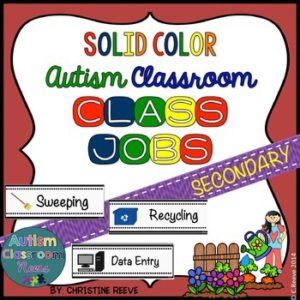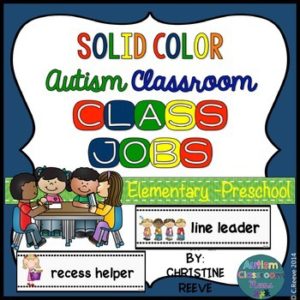Sharing is caring!
We all have at least one student we work with who really challenges us with his behavior. I’ve worked with many of them, since that’s my jam. But did you know that something as simple as assigning student jobs in the classroom to those same students can sometimes improve their behavior?
What About Bob?
The other day I was doing a functional behavior assessment on a student I’ll name Bob who struggles with impulse control and yet wants to control everything else in his environment. Bob’s just not happy unless he is the center of attention. Sound familiar? The function of his behavior appears to be to gain attention. Like many of our students, Bob is more likely to use negative than positive behavior to do it. After all, pulling another kid’s hair gets a big reaction from adults and kids, but raising his hand and waiting for the teacher to call on him doesn’t. OK, I can work with that. Once I know the function, I can start to think about what he should do to meet that same need.
 But here’s the thing. Because pulling the hair gets a bigger reaction, just teaching him to ask for attention that isn’t as exciting may not work. Bob’s behavior isn’t reinforced just by the teacher calling on him. His behavior is reinforced by being the “center of attention!” So, in developing my replacement behaviors, I have to think about things that will increase his appropriate opportunities to be the center of attention.
But here’s the thing. Because pulling the hair gets a bigger reaction, just teaching him to ask for attention that isn’t as exciting may not work. Bob’s behavior isn’t reinforced just by the teacher calling on him. His behavior is reinforced by being the “center of attention!” So, in developing my replacement behaviors, I have to think about things that will increase his appropriate opportunities to be the center of attention.
Types of Student Jobs in the Classroom
Let me clarify what I mean when I talk about student jobs in the classroom–because really there are two kinds. First, there are the formal jobs that we typically assign daily or weekly. Often they get a subset of students involved each week being the one who passes out the papers or cleans up the snack table. They are our line leaders, our light mangers, and our pencil sharpeners.
Then there are the informal jobs we create for students. I’m a BIIIG fan of these. These are the jobs we either create for a specific reason or student. Or they are the jobs we have kids do with us to keep them busy, engaged, or allow a staff member to leave the room (taking the student with her). They are the “I need your help to get my mail” and the “Can you take this message to the office for me” jobs. They aren’t planned and they don’t happen regularly. But they give responsibility to a student to perform a specific task, either with or without an adult.
I’m going to talk about both of these types of student jobs in the classroom in this post.
But Why Would I Give This Student a Job?
So, you may be thinking….this is great, but she doesn’t understand that my student can’t be trusted to take the mail to the office. Or my student has a meltdown whenever I ask him to do anything he HAS to do. Why would I ask him to do more? Or I can’t possibly “reward” this kid’s behavior by giving him a job!
But….what if I told you that assigning him a job can make his behavior BETTER? Wonder how that can happen?
3 Reasons To Use Student Jobs in the Classroom
They Promote Appropriate Ways to Gain Attention

One of the most significant reasons I recommend student jobs in the classroom is because it’s a great way for them to be the center of attention for appropriate behavior. It gives you something you are entrusting to them that you can give lots of attention for completing. And because it’s perceived as a special opportunity, the student is more likely to follow through.
Typically when I assign jobs to the students, I present it as asking them to do me a favor. You have to be careful with this because some students will say “no” if you actually ask “Will you do X for me?” However, if I approach it as “I really need someone to carry this to music for me….will you do me a favor and take it?” I often get kids ready to do that. And then you can thank them profusely and make a big fuss about what a great helper they were. This works whether your students are 3, 13, or 21…you just might change the language you use to ask.
Think about it…didn’t you feel special in your classroom if your teacher asked you to do something for you? It’s the same thing…but you are the teacher. Why should you give such a special opportunity to the student with problems? Because it focuses on what he can do and does appropriately. When appropriate behavior gets him the center of attention, and negative behavior gets a smaller reaction, appropriate behavior increases. And that’s what behavior support is all about.
It Keeps Them Engaged
Have kids like Bob who have poor impulse control and you feel like they are in constant motion? They are the kids you find problems occurring primarily during transitions or when they finish something early. To address that we can approach it from two angles simultaneously. First, we want to teach him to stop and think and/or wait. But, while he is learning, we can prevent some challenges by giving them a job during those transitions or when they finish early. This keeps them engaged in meaningful activity, has the benefits of being given responsibility, and thereby reduces problem behavior. Typically I use informal jobs for this, but if there are times that are regularly problematic, you could put it on his schedule or make it an assigned job.
I've said this before and I'll say it again, downtime is not your friend in any classroom. Click to TweetBuilds Self-Confidence
Many students with challenging behavior exhibit it because they expect a negative outcome. They have an internal dialogue that they will screw things up. And they have learned, as I noted before, that negative behavior attracts attention more quickly, more reliably, and probably more attention than positive behavior (i.e., it’s more efficient at gaining attention). Giving a student responsibility and entrusting him to do something that you are presenting as a favor to you sends the message that he can do it. It’s a vote of confidence in his ability to help. It also builds leadership skills. Let’s face it, these kids are the persistent ones who are going to have the best likelihood of being leaders in their worlds. Jobs present them with ways to lead appropriately.
Next Steps
In my next post I’m going to focus on how we present jobs and different ways we can use them to help students like Bob. In the meantime, while student jobs in the classroom will not solve all of Bob’s behavioral issues, it is a piece of his support plan to gain attention appropriately and to keep him engaged. Obviously there are other components like teaching him to use communication more effectively, teaching him self-regulation and self-monitoring for impulse control, and reinforcement of appropriate behavior (with decreased attention to the negative behavior)….and more. Nonetheless, the jobs are part of his routine, both formal and informal, to help keep him engaged and “out of trouble.”
Are you having trouble thinking of types of classroom jobs or need visuals to support them? Check out my visual bundles on TpT…
Until next time,











